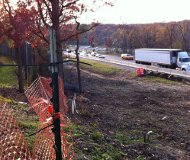4/8/2013
Virginia Residents Protest Against Toll RoadsVirginia residents protest latest plan to convert freeway lanes into a toll road.

About 100 residents of Alexandria, Virginia gathered Saturday to protest the conversion of the Interstate 395 high occupancy vehicle lanes into a toll road. The Concerned Residents of Landmark, a group representing eight homeowners associations in the area, are concerned that the plan includes building an elevated ramp that will raise freeway traffic up to the level of nearby homes, within 75 feet of some buildings. The Virginia Department of Transportation (VDOT) chose to end the toll road at the Landmark location instead of running the toll lanes all the way to Washington, DC because the city of Arlington filed a lawsuit that blocked the toll road from extending north through the city.
"VDOT has shirked its moral and legal duty to ensure its planned actions cause no harm to surrounding environment," the group explains on its website, Delay the Ramp. "In its rush to build, VDOT arbitrarily and without careful analysis selected the Turkeycock Run location, not because it was the best site, but because it was convenient and VDOT wanted to make up for time lost fighting the Arlington case."
Unlike most "not in my backyard" efforts, the group is not protesting an actual expansion of the interstate. The I-395 toll project is an effort to re-stripe the existing footprint of lanes that are for carpool use during rush hour and free for anyone to use during off-peak hours. Once converted to tolling, the lanes will run for the profit of Transurban, an Australian corporation.
The protest group paid $70,000 to hire an engineer with the firm Air Expertise Colorado to conduct an independent assessment of VDOT's plan. The study counted about 6250 vehicles per hour crawl in the general purpose lanes at about 13 to 15 MPH during the morning rush hour, with average speeds higher during the evening commute. About 900 cars per hour take the current HOV lane ramp in the morning. This is expected to increase significantly as single-occupant vehicles taking the toll road "bail out" to surface streets to avoid the bottlenecked traffic as the toll lane merges back into the general purpose lanes.
"Having confirmed the poor levels of surface for the general purpose lanes, the Turkeycock ramp and the weave lanes, Air Expertise analyzed the specific local impact of the stop-and-go and queuing traffic so close to residential neighborhoods," Maureen Barret wrote in her report. "Queuing traffic (idling; stop-and-go) increases pollutant emissions."
The report found various types of air pollutants, including nitrogen dioxide, fine particles (PM2.5) and formaldehyde would exceed federal maximums.
"The maximum impact of the overall project exceeds the short-term and long-term health-based standards," Barret wrote. "However, this analysis is not intended to, nor does not, substitute for a full health-risk analysis of the risk of exposure to mobile source air toxics pollutants."


